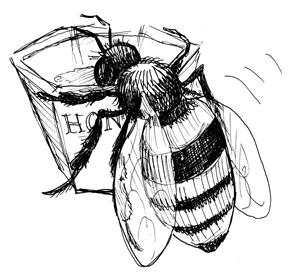STRANGE BUT TRUE- No spit! Bees masticate to make honey

Q. Ever had a taste for regurgitated bee spit? –M. Condon
A. You have if you like honey. To make a pound of it requires some 60,000 nectar loads, or four million flower visits by individual bees, totaling 100,000 miles or more, says May Berenbaum in Bugs in the System.
Most nectars are 90 percent water, honeys less than 20 percent. To concentrate honey from nectar, worker bees repeatedly eat and regurgitate it onto their tongues, hundreds of times, aerating it and drying it out, while other bees fan their wings up to 26,000 times a minute to keep air circulating in the hive to facilitate the curing.
Q. Maybe you think you own the 24,000 genes passed along to you by your parents in creation of your body and mind. Well, think again. –F. Crick
A. Actually, more than 4,000 of the 24,000 human genes stored in the (US) National Center for Biotechnology Information database are tagged with at least one patent, as reported by Science magazine. Incyte Corp. of Wilmington, Delaware alone owns nearly 10 percent of all human genes, says Scientific American.
But how can my genes be patented? people will ask. And what happens to cancer research when half of all known cancer genes are patented? Some 25 years ago the U.S. Supreme Court ruled that living things are patentable, so long as they are "manmade." Importantly, it is not the actual genes in your body that are owned by corporations, universities or others, but rather "an isolated and purified form" of them, meaning the patent holder on an isolated and cloned gene has rights to market the protein manufactured– say, insulin or human growth hormone– in the same way a chemical company might purify a B vitamin and patent it.
Weirder still is the Harvard University OncoMouse, the animal itself patented by scientists who created it with a gene predisposing it to contract cancer, valuable for their research. "The addition of the oncogene meant that this was a mouse 'invented' by a human," says Scientific American. The whole notion troubles many, with much yet to be thrashed out on this controversial matter.
Q. If you could gather all the world's gold into one room, how big would the room need to be? – K. Midas
A. Writing in The Secret House, mathematician David Bodanis estimates that a room 50 feet by 50 feet by 50 feet could probably contain the world's entire gold production since the start of history.
"What was gold once stays gold for years– centuries– to come. This has some interesting consequences. One is that much of the gold we use today was used as gold in previous ages, and only by an extraordinary mix of sales, thefts, melting down, and re-melting has it ended up in the gold earring about to be put on before the dinner party."
Q. Is it alcohol, marijuana, cocaine or something else that causes people to report, "The tabletop is beginning to waver, the floor is covered with spiderwebs, faces are flashing on and off, running water sounds like talking voices, a ring of pressure is encircling my forehead like a hat"? –T. Leary
A. Forget drugs. These are statements by test subjects after only 60 hours of sleeplessness, says A. Borbely in Secrets of Sleep. One theory is that dream fragments erupt into waking consciousness, causing delusions and hallucinations. Yet the subjects experienced little change in blood pressure, body temperature, heart or respiration rates, and all felt fine after about a full day of catch-up sleep.
For the all-time no-sleep champ, The Guinness Book of Records lists 17-year-old Randy Gardner, who went 11 full days while at times having to walk around to keep from dropping off. Then on his last night, a bleary-eyed Randy managed to beat sleep researcher William Dement in 100 straight games of pinball before sacking out for 15 solid hours.
Q. Just about everybody loves a rainbow. Now answer this: Can you ever touch a rainbow or reach its end? –J. Garland
A. No, because it's only an image, not an object, say Raymond Lee Jr. and Alistair Fraser in The Rainbow Bridge. However, in the same way you can touch a mirror but not your image in it, you can touch the water drops that create the bow, as when you touch the sunlit spray of a sprinkler making a small bow. "That's quite different from the impossible feat of touching the rainbow's image," Lee says.
Other rainbow misconceptions: A rainbow can never be seen obliquely, as many artists have painted it, but only straight on. Also, the sun can never be seen peeking out from behind one. To see a rainbow, you must stand with the sun directly behind you and the rain before you, say Penn State researchers. The rainbow will appear around the head of your shadow. So in fact, "No two people see exactly the same rainbow because each sees it around the head of his or her own shadow. Which also means you can't run away from it or catch it, although people try."
Science now knows that small spherical drops yield pastel colors near the top of the arch, while bigger faster-falling elliptical drops near the base create the stronger shades. So you see a bright glow of vivid colors near the rainbow's end, says Lee.
"Surely in that direction we can find an object with a golden glow– perhaps a pot of gold!"
Send Strange questions to brothers Bill and Rich at [email protected].
#